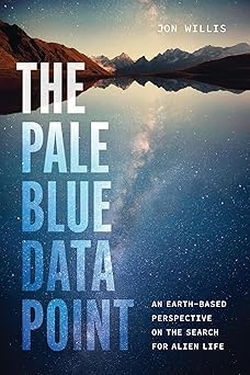Centauri Dreams
Imagining and Planning Interstellar Exploration
Across the ‘Jupiter Gap’
A great part of the excitement of scientific discovery is not knowing what will emerge when you take data. Our space missions have proven that time and again, and I have no doubt that as we tighten the resolution on future telescopes, we’ll find things that defy many an accepted theory. NASA’s Stardust mission reflects the phenomenon. Designed as a comet sample return, Stardust is now providing information about the migration of materials in the primordial Solar System, which may point toward a phenomenon more widespread than earlier believed.
Thus the work of Devin Schrader and Jemma Davidson (University of Arizona Center for Meteorite Studies). Working with colleagues at the Smithsonian Institution’s National Museum of Natural History, the University of Hawai?i at M?noa, Washington University in St. Louis, and Harvard University, the duo have produced evidence that at least fragmentary materials in the inner Solar System crossed what is often called the ‘Jupiter Gap’ and moved much further from the Sun. The Stardust samples produced evidence for the kind of migration that the authors then followed up by analyzing numerous samples of early chondrite meteorites.
Says Schrader:
“This research provides new information about the dynamics of the early Solar System. Our research shows that these two reservoirs were not completely isolated from one another.”
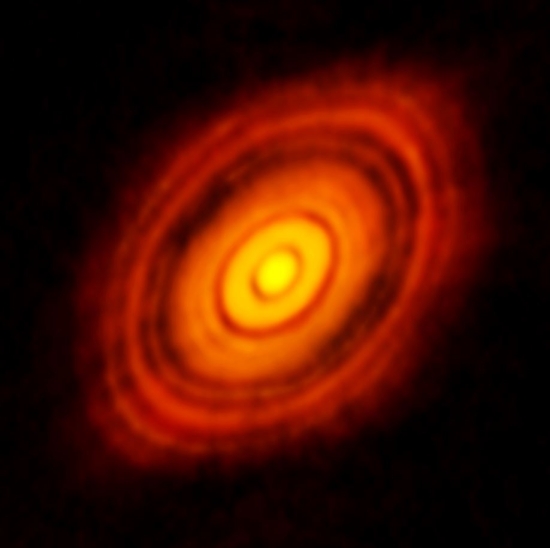
Image: Atacama Large Millimeter Array image of the protoplanetary disk around HL Tauri. The dark rings are gaps in the dust and gas-rich protoplanetary disk, likely due to the formation of planets. These gaps may be similar to the disk gap thought to be formed by the formation of Jupiter in our protoplanetary disk. Credit: ESO/ALMA.
The so-called Jupiter Gap should be examined within the context of current theories of gas giant formation. A gas giant core of between 5 and 10 Earth masses likely formed about 1 million years into the growth of the new system, soon drawing in a dense atmospheric envelope. The gravitational influence of this world would be sufficient to create a gap in the disk of gas and dust around the Sun out of which the planets we see today emerged. The idea that material might somehow cross this divide to move from one disk reservoir to another seemed unlikely.
But the matter demanded exploration because the degree to which such mixing occurs in protoplanetary disks is unresolved, and the nature of the chemical and physical structure of the resulting system depends on it. It’s a complicated analysis, one in which scientists must plug in the conservation of angular momentum as they study the migration of tiny particles, the role played by the pressure of the gases involved and the drag within them, and the effects of whatever planetesimals and larger objects begin to emerge from the mix.
The idea of a Jupiter Gap emerged out of modeling of these factors in various studies in the literature, and it combines with analyses of the calcium- and aluminum-rich inclusions in chondrites, with the prediction that while smaller particles (less than 300 ?m) could pass through the gap, larger particles would be blocked. And thus we would have differences in the isotopes found in meteorites formed in the inner system (non-carbonaceous) and those that formed in the outer system (carbonaceous chondrites) up to 4 million years after the system’s birth.
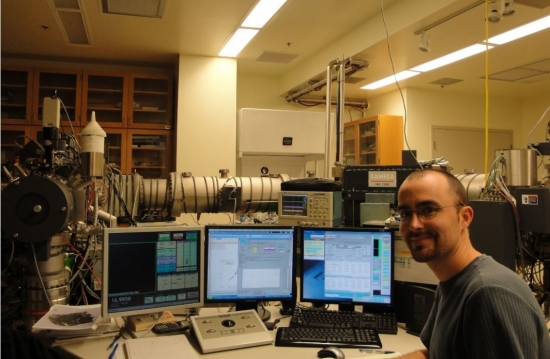
Image: Associate Research Professor Devin Schrader uses the ion mass spectrometer at the University of Hawai?i at M?noa to determine the isotopic composition of individual minerals in meteorites. Photo credit: Devin Schrader/ASU.
Samples of both are fortunately abundant at the various institutions involved in Schrader and Davidson’s work. The scientists deployed electron probe microanalyzers for imagery and analysis of individual minerals and a secondary ion mass spectrometer to analyze the isotopic composition of the samples. The round grains known as chondrules found in chondrites as part of their earliest formation, particularly those that were only partially melted during formation (‘relict grains’) provide evidence of chondrite formation and early transport within the disk.
The population of chondrites is fortunately varied enough to make fine distinctions among them by measuring the chemical and oxygen isotope compositions of relict grains in their chondrules, allowing the authors to differentiate between their origins and discuss disk transport within the first 4 million years of the Solar System’s formation. The mixing between inner and outer Solar System, occurring despite the Jupiter Gap, seems to have been complex and widespread. It will be interesting to see what analysis of asteroid samples from Hayabusa2 and OSIRIS-REx, both expected within the next several years, may yield in support or refutation of this theory.
The paper is Schrader et al., “Outward migration of chondrule fragments in the early Solar System: O-isotopic evidence for rocky material crossing the Jupiter Gap?” Geochimica et Cosmochimica Acta Volume 282 (1 August 2020), pp. 133-155 (abstract).

Ceres: The Lesson of Occator Crater
We learned some time ago from the Dawn mission just how interesting a place Ceres is. If you’re wanting to dig into the latest research on the dwarf planet, as it is now termed, be aware that a collection of papers has appeared in Nature Astronomy, Nature Geoscience and Nature Communications, all published on August 10. These analyze data gathered during Dawn’s second extended mission (XM2) phase, which closed with a series of low orbits as close as 35 kilometers from the surface. Rather than listing these papers separately, I’ll just offer this link to the entire collection at nature.com.
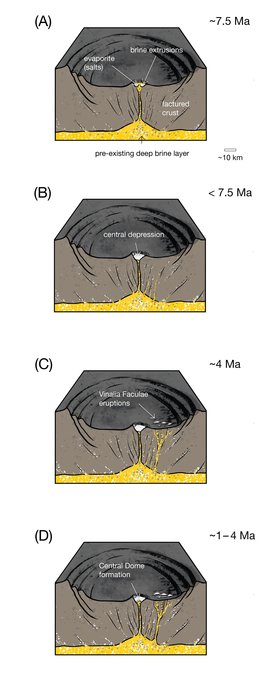
The upshot is that we’re continuing to learn about a small world that remains surprisingly active. Let’s home in on cryovolcanism, which leverages the temperature differential between a frozen world’s interior water and its frigid surface to produce ejections. These are becoming almost common — think Enceladus, for example, and then remember what Voyager saw at Triton. The thinking has been that some kind of cryovolcanism makes sense in the outer Solar System because the gas and ice giants place gravitational stresses on their moons that warm their interior.
But Ceres? Not only is it the only dwarf planet inside Neptune’s orbit, but it’s also the largest of the main belt asteroids. You would think that orbits between Mars and Jupiter, which are obviously not associated with the tidal forces of a closely orbited gas giant, would produce inactive bodies. The Dawn data and the papers it has spawned indicate otherwise. Dawn, studying Ceres from 2015 to 2018, shows us a world of 950 kilometers diameter that is active and possessed of its own form of cryovolcanism. At the core of these studies is Occator Crater, about 92 kilometers in diameter and possessed of a remarkably bright, white coloration.
Image: Through eruptions of brine from the interior of dwarf planet Ceres, Occator Crater received its current shape over millions of years. Credit: © Nathues et al., Nature Astronomy.
The evidence of Occator Crater argues for the remains of a global, salty ocean, a briny mixture that remains liquid and may still be escaping from the interior. We know that the European Space Agency’s Herschel Space Observatory produced evidence of a sporadic exosphere, thin but containing water. A thin haze was spotted during the Dawn mission over Occator Crater, though only intermittently, and apparently young deposits of salt compounds containing water turn up in analysis of the Dawn spectrometer data, as presented in a paper from the Dawn spectrometer team led by the Istituto di Astrofisica Spaziale e Fisica Cosmica in Italy.
“We assume that Ceres is still occasionally cryovolcanically active,” says Andreas Nathues (Max Planck Institute for Solar System Research, Germany), who led a team evaluating high-resolution imagery of Ceres during the final phase of the Dawn mission. Indeed, the bright white coloration found at Occator Crater was picked up during the approach to Ceres, and yielded to subsequent analysis. “On closer inspection, Occator Crater has a very complex structure with elevations, a large central depression, deposits, cracks, and furrows,” Nathues continues. “In all its details, this became clear only during the final phase of the mission.”
Without a source of internal heating, the deep dive into Occator Crater found in the new papers tells us that this is nonetheless a world rich in water, one containing a brine reservoir believed to be about 40 kilometers deep and several hundred kilometers in width. This would explain Occator’s bright areas, which are found to be deposits made largely of sodium carbonate that would have moved up to the surface only to evaporate, leaving the reflective salt crust behind. It’s the deep reservoir of brine found by studying Ceres’ gravity that helps us parse its interior structure. Significantly, crustal density here increases with depth well beyond the effects of pressure.
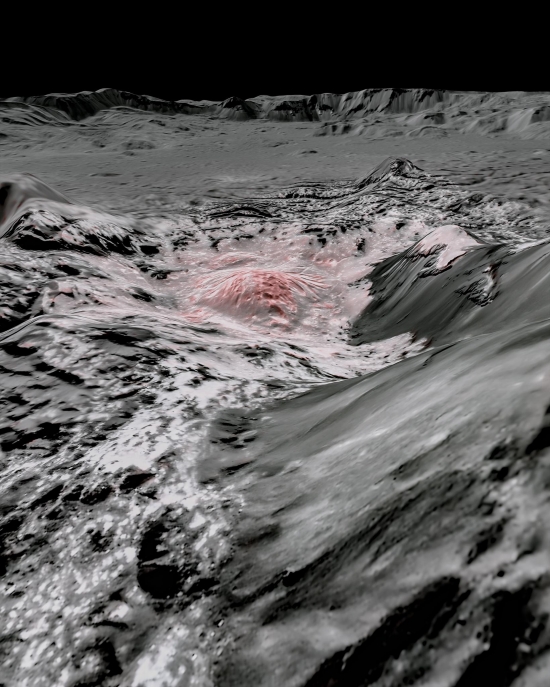
Image; NASA’s Dawn spacecraft captured pictures in visible and infrared wavelengths, which were combined to create this false-color view of a region in 92-kilometer-wide Occator Crater on the dwarf planet Ceres (in the main asteroid belt between Mars and Jupiter). Here, recently exposed brine, or salty liquids, in the center of the crater were pushed up from a deep reservoir below Ceres’ crust. In this view, they appear reddish. In the foreground is Cerealia Facula (“facula” means bright area), a 15-kilometer-wide region with a composition dominated by salts. The central dome, Cerealia Tholus, is about 3 kilometers across at its base and 340 meters tall. The dome is inside a central depression about 900 meters deep. Credit: NASA/JPL-Caltech/UCLA/MPS/DLR/IDA.
As Dawn examined the surface from a range of altitudes, it captured images of two areas within Occator Crater — Cerealia Facula and Vinalia Faculae — whose very brightness was unusual, an indication that they were youthful enough not to be darkened by micrometeorite debris. Subsequent research analyzed in this collection has shown that these faculae (bright areas) are less than 2 million years old. Moreover, the salt compounds of Cerealia Facula — sodium chloride bound with water and ammonium chloride — reached the surface only recently.
“For the large deposit at Cerealia Facula, the bulk of the salts were supplied from a slushy area just beneath the surface that was melted by the heat of the impact that formed the crater about 20 million years ago,” said Dawn Principal Investigator Carol Raymond. “The impact heat subsided after a few million years; however, the impact also created large fractures that could reach the deep, long-lived reservoir, allowing brine to continue percolating to the surface.”
So we have two paths that allow liquids to reach the surface. Again, this is happening in the absence of gravitational interactions with planets, an indication that if Ceres is active, so too may be other ice-rich bodies in the outer Solar System. Small conical hills on Ceres analyzed in this work are another avenue showing the effect of frozen groundwater.
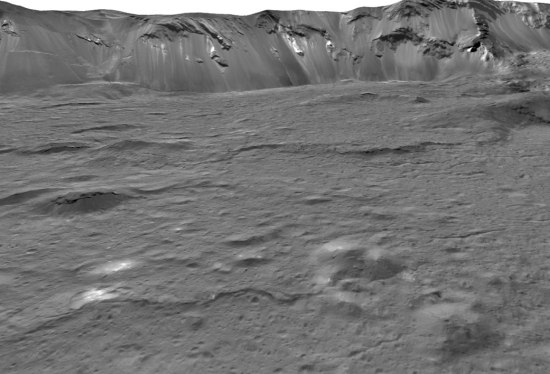
Image; This mosaic of Ceres’ Occator Crater is composed of images NASA’s Dawn mission captured on its second extended mission, in 2018. Bright pits and mounds (foreground) were formed by salty liquid released as Occator’s water-rich floor froze after the crater-forming impact about 20 million years ago. Credit: NASA/JPL-Caltech/UCLA/MPS/DLR/IDA/USRA/LPI.
So we have brine from below the surface pushed upward, the water evaporating, and bright salty deposits left behind, with the remains of a once global ocean surviving and producing a form of cryovolcanism that is most likely still ongoing. The impact that formed Occator Crater occurred perhaps 22 million years ago, with the subsequent subsiding of the inner part of the crater resulting from the loss of material from the interior.
But what stands out in these papers is that brine continued to reach the surface for millions of years afterwards, and may be part of a process that still occurs, as opposed to being the result of a one-time event caused by meltwater from the initial impact. Another dwarf planet turns out to be surprisingly active, as the once enigmatic Occator Crater demonstrates.

Lunar Eclipse: A Proxy for Exoplanet Observation
When it comes to detecting life on planets around other stars, my guess is that what will initially appear to be a life signature will quickly become controversial. We might, for example, find ozone in an exoplanet atmosphere with a space telescope like HabEX (Habitable Exoplanet Observatory). That would lead to hyperbolic news stories, to be sure, but ozone can happen when nitrogen and oxygen are exposed to ultraviolet light. The presence of ozone makes no definitive statement about life.
In fact, definitive statements about life may take more than a few decades to achieve. If ozone seems like a good catch, that’s because it implies oxygen, which makes us think of photosynthesis, but oxygen itself is hardly infallible as a biosignature. Oxygen-rich atmospheres can be completely abiotic, with UV from the host star breaking down carbon dioxide. For that matter, an atmosphere rich in water vapor can produce oxygen and hydrogen through the effects of UV radiation.
Better, then, to look for a mix of things. Methane and oxygen detected simultaneously would be interesting because the two would need constant replenishment to appear together, indicating a lack of chemical equilibrium, and surely that’s a life signature. Or is it? Volcanoes can produce methane [although see Brig Klyce’s comment below], and so can infalling carbon-rich debris entering an atmosphere.
No, given the significance of the find and the difficulties in the measurement, I don’t expect anything but ambiguity when we do get the right instrumentation to study terrestrial-class worlds transiting their stars. We’ll be looking at starlight screened through a thin layer of atmosphere, and I thInk we can expect a battle royal among astronomers as we try to decide among the possible causes of the chemical signatures we do find.
And then there’s the question of just where a particular planet is in its development. Our planet when young was rich in hydrogen and helium, but later volcanic eruptions would supply carbon dioxide, water vapor, sulphur. No oxygen, yet, but if we find these signatures in an exoplanet atmosphere, we may be looking at a world that will one day experience an oxygenation event like the one that changed everything on Earth two and a half billion years ago.
How tricky atmospheric biosignatures turn out to be. All this gets more complicated still because of the fact that we need an observing campaign at different wavelengths to make a detection of the different gases involved.
But ozone seems like a logical place to start. Giada Arney (NASA GSFC) is co-author of a paper that addresses biosignatures in a more local way, as I’ll explain after her quote:
“Astronomers will also have to take the developmental stage of the planet into account when looking at younger stars with young planets. If you wanted to detect oxygen or ozone from a planet similar to the early Earth, when there was less oxygen in our atmosphere, the spectral features in optical and infrared light aren’t strong enough. We think Earth had low concentrations of ozone before the mid-Proterozoic geological period (between roughly 2.0 billion to 0.7 billion years ago) when photosynthesis contributed to the build up of oxygen and ozone in the atmosphere to the levels we see today. But because the ultraviolet-light signature of ozone features is very strong, you would have a hope of detecting small amounts of ozone. The ultraviolet may therefore be the best wavelength for detecting photosynthetic life on low-oxygen exoplanets.”
Arney, working with Allison Youngblood (Laboratory for Atmospheric and Space Physics, University of Colorado, Boulder) and colleagues, has explored ozone detection close at hand through new Hubble observations. The idea here is to use light reflected off the Moon during a lunar eclipse to try to detect biosignatures in Earth’s own atmosphere. Consider it a test case for the kind of atmospheric characterization we hope to be doing with much more distant worlds in coming decades. Have a look at how things lined up for this observation.
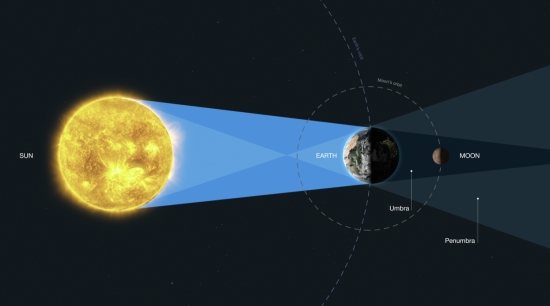
Image: This diagram explains the geometry of the lunar eclipse. When the Moon is entirely in the Earth’s umbra (known as a total lunar eclipse or umbral eclipse), all sunlight reaching the lunar surface has been refracted or scattered through Earth’s atmosphere. When the Moon is in Earth’s penumbra (known as a penumbral eclipse), illumination comes from both direct sunlight and sunlight refracted and scattered through the planet’s atmosphere. This process is similar to an exoplanet transit observation. Credit: M. Kornmesser (ESA/Hubble), NASA, and ESA.
As you can see, the Moon is reflecting sunlight that has passed through Earth’s atmosphere before being reflected back to Hubble. Make no mistake, we’ve done this kind of thing before — Earthshine has its uses — but this is the first time a total lunar eclipse has been captured at ultraviolet wavelengths and from a space telescope, so it’s a decent proxy for what we’ll do later with HabEX and other instruments. Hubble found a strong ozone signature, a photochemical byproduct of molecular oxygen we’ll hope to be finding on rocky exoplanets.
The strength of the ozone signature demonstrates the problem with working with ground-based observations at these wavelengths, for Earth’s atmosphere absorbs ultraviolet light. This work, along with other observations — ground-based but at different wavelengths — of the January 20-21, 2019 lunar eclipse, helps to develop spectral models for atmospheric characterization. The weakness of the lunar eclipse as a proxy is also clear, as the paper notes:
…observing the moon with HST has different challenges, namely lower spectral resolution and pointing instability. The moon is not a homogeneous surface, and pointing instability does not guarantee that the overall albedo and reflectivity spectrum of the lunar surfaces observed in-transit and out-of-transit are identical. Creating transmission spectra with only Earth’s spectral signatures relies on the in-transit and out-of-transit solar and lunar features being identical. We find evidence for overall albedo variations of the moon between our out-of-eclipse spectra, but defer a thorough analysis to a future paper.
This, too, is helpful, though, for previous papers in the literature have analyzed problems of refraction and transit geometries as they affect the exoplanet spectroscopic signature. The models for future work are only now being tested through events like these.
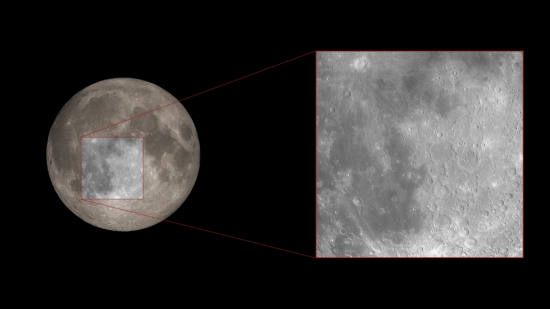
Image: This ground-based telescopic image of the Moon highlights the general region where astronomers used NASA’s Hubble Space Telescope to measure the amount of ozone in Earth’s atmosphere. This method serves as a proxy for how they will observe Earth-like planets around other stars in search of life. Credit: M. Kornmesser (ESA/Hubble), NASA, and ESA.
The paper is Youngblood et al., “The Hubble Space Telescope’s Near-UV and Optical Transmission Spectrum of Earth as an Exoplanet,” Astronomical Journal Vol. 160, No. 3 (6 August 2020). Abstract / Preprint.

A Dense Sub-Neptune Challenges Formation Theories
The exoplanet K2-25b, a young world in the Hyades cluster orbiting an M-dwarf star, raises intriguing questions. We’d like to know how it formed, for K2-25b is much more dense than we would expect for a world slightly smaller than Neptune. Planets in a range between Earth and Neptune seem to be common around other stars, although we have none in our Solar System unless we make an interesting discovery about putative Planet 9.
But let lead author Gudmundur Stefánsson (Princeton University) point out the unusual nature of K2-25b::
“The planet is dense for its size and age, in contrast to other young, sub-Neptune-sized planets that orbit close to their host star. Usually these worlds are observed to have low densities — and some even have extended evaporating atmospheres. K2-25b, with the measurements in hand, seems to have a dense core, either rocky or water-rich, with a thin envelope.”
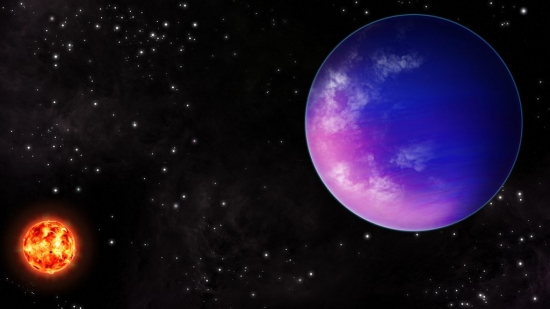
Image: New detailed observations with NSF’s NOIRLab facilities reveal a young exoplanet, orbiting a young star in the Hyades cluster, that is unusually dense for its size and age. Slightly smaller than Neptune, K2-25b orbits an M-dwarf star — the most common type of star in the galaxy — in 3.5 days. Credit: NOIRLab/NSF/AURA/J. Pollard.
Let’s put this world into the context of giant planet formation because of its unusual density. A widely studied scenario would have gas giants forming through the accretion of disk materials into a core of ice and rock some 5 to 10 times the mass of Earth. A massive gas envelope hundreds of times the mass of Earth is then drawn in through gravitational interaction with the still young disk. K2-25b’s mass — some 25 times that of Earth, and thus possessed of robust gravitational pull — has emerged without accumulating more than a tenuous gas envelope.
This planet is a Kepler discovery and a world producing a large transit depth, one mentioned in the literature as a candidate for atmospheric characterization by the James Webb Space Telescope. Particularly useful is the fact that its mass, radius and even the tilt of its orbit have been determined with the help of the Habitable-zone Planet Finder (HPF), a spectrograph out of Penn State installed on the 10-meter Hobby-Eberly Telescope at McDonald Observatory in Texas.
The size measurement was tightened with observations at Kitt Peak’s WIYN 0.9-meter telescope and the 3.5-meter telescope at Apache Point Observatory in New Mexico. I mention both because Stefánsson subjected their data to an engineered diffuser, a beam shaper that effectively spreads the light from the star to allow more accurate measurements of the planetary transit. This in turn allows transit prediction for K2-25b to be reduced from a window of 30-40 minutes to 20 seconds in a technique Stefánsson developed in his doctoral thesis.
Here you may remember Stefánsson’s name in connection with the exoplanet G 9-40b, where he used diffuser-assisted photometry at Apache Point to tighten transit timing (see G 9-40b: Confirming a Planet Candidate). Tightening the shape of the transit can be invaluable, says Jayadev Rajagopal (National Optical-Infrared Astronomy Research Laboratory), a co-author of the paper:
“The innovative diffuser allowed us to better define the shape of the transit and thereby further constrain the size, density and composition of the planet. Smaller aperture telescopes, when equipped with state-of-the-art, but inexpensive, equipment can be platforms for high impact science programs. Very accurate photometry will be in demand for exploring host stars and planets in tandem with space missions and larger apertures from the ground, and this is an illustration of the role that a modest-sized 0.9-meter telescope can play in that effort.”
The authors of the paper on this work consider K2-25b to be a ‘useful laboratory’ for examining planet formation. If so, it’s a laboratory with unexplained secrets. Why didn’t K2-25b experience runaway gas accretion to produce a gas giant? The paper offers one possible solution:
…we surmise that K2-25b could be the product of planet merging events of smaller planetary cores to produce a more massive planet. Such a dynamical environment could have excited K2-25b into an eccentric orbit, and K2-25b could be in the process of migrating to a shorter period orbit through tidal interactions with the host star. To explain K2-25b’s current moderate eccentricity from tidal circularization theory, we place a lower limit on the tidal quality factor of Qtp ? 105, corresponding to a circularization timescale consistent with the age of the system. This tidal quality factor is higher than the tidal quality factor for Neptune, which suggest that K2-25b’s internal structure could be different than that of the small gas-giants (Uranus, Neptune) in the Solar System.
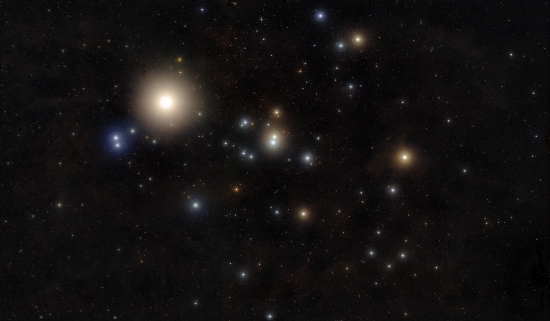
Image: Wide-field view of the Hyades star cluster created from images forming part of the Digitized Sky Survey 2. Credit: NOIRLab/NSF/AURA/Digitized Sky Survey 2.
Follow-up observations will include transit spectroscopy on data from the Transiting Exoplanet Survey Satellite (TESS) mission, whose target list includes K2-25b. Also useful will be NEID, an extreme precision radial velocity spectrometer installed at Kitt Peak’s WIYN telescope. A pertinent astronomical reference is TOI 849b, a possible exposed planetary core — see An Exposed Planetary Core at TOI-849 for more on this one and its similar issues re planet formation.
The paper is Stefánsson et al., “The Habitable-zone Planet Finder Reveals A High Mass and a Low Obliquity for the Young Neptune K2-25b,” accepted at the Astronomical Journal (preprint).

Saturn-class Exoplanet Is a Win for Astrometry
Under other circumstances, the red dwarf TVLM 513-46546 would not cause a ripple in news coverage of exoplanets. What astronomers have found there is a planet of Saturn mass in a 221 day orbit, raising eyebrows only in that while planets are common around M-dwarfs, they are usually smaller, rocky worlds. But the TVLM 513-46546 story gains weight when we consider the methods used to find this planet, which have implications for studying system architectures around many stars as we refine our techniques and new instruments come online.
The star in question is 35 light years from Earth, and we’ve found the planet through astrometry, a method that tracks a star’s position in the sky to an extreme precision and detects the minute variation in motion caused by the gravitational effect of the planet. If this sounds a bit like radial velocity methods, the difference is that with astrometry we are measuring tiny changes in the stars position in the sky, as opposed to the Doppler shift of light from a star as it moves towards us and then away from us, influenced by the gravitational tug of a planet.
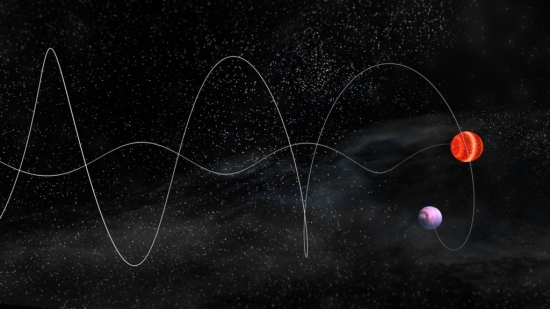
Image: Illustration shows how the star’s motion around the center of mass between it and the planet causes a “wobble” in its motion through space. The VLBA’s ability to detect this minuscule effect revealed the presence of the planet. Credit: Bill Saxton, NRAO/AUI/NSF.
The two methods complement each other in the sense that they are sensitive to planets in different kinds of orbits. Radial velocity works most readily with planets orbiting close to their star, where the gravitational effects are most apparent in the Doppler signature. The great challenge for radial velocity is increasing its sensitivity to smaller planets at progressively larger distances from the star, work that is proceeding through new spectrographs like ESPRESSO.
Astrometry, on the other hand, is more sensitive to massive planets that are distant from their star. This is useful indeed, for while radial velocity can’t yet track such worlds, neither can transit methods, or to put it more precisely, a distant orbit involving, say, 10 years would require such long observing periods to confirm that we would be unlikely to register such transits more than once. If astrometry can be made to work, we have a method for finding planets whose position in their stellar system is more like that of Saturn or Jupiter in our own. Thus astrometry finds the kind of planet hitherto accessible only through gravitational microlensing or direct imaging.

Image: Illustration of the planetary system TVLM 513-46546; the newly discovered Saturn-like planet is seen in front of its host star, a small and cool red dwarf. Credit: © Luis A. Curiel Ramirez.
Which makes the planet around TVLM 513-46546 a bit odd, in that it is relatively low in mass given the demands of astrometry. Salvador Curiel (National Autonomous University of Mexico) is lead author of the paper on this work, which appears in the Astronomical Journal:
“Giant planets, like Jupiter and Saturn, are expected to be rare around small stars like this one, and the astrometric technique is best at finding Jupiter-like planets in wide orbits, so we were surprised to find a lower mass, Saturn-like planet in a relatively compact orbit. We expected to find a more massive planet, similar to Jupiter, in a wider orbit. Detecting the orbital motions of this sub-Jupiter mass planetary companion in such a compact orbit was a great challenge.”
This is a rare win for astrometry, which has been considered since the 19th Century as a way of finding planets around other stars. Indeed, it was astrometrical data that convinced Peter van de Kamp that Barnard’s Star had one or more planets. The astronomer had been analyzing data from the Sproul Observatory at Swarthmore College for decades, but it was later learned that systematic errors in the calibration of the telescope had produced the apparent effect.
As you might expect, the tiny variation in stellar position caused by even a large gas giant is extremely tricky to measure. We can thank the antennae at the Very Long Baseline Array for the TVLM 513-46546 catch, which becomes the first discovery of an exoplanet with a radio telescope using astrometric techniques, and in fact only the second exoplanet discovery for both radio telescopes and astrometry itself. The only other exoplanet discovered using astrometry is HD 176051 b, associated with a relatively nearby (roughly 48 light years) binary system.
In addition to future work at the VLBI, the authors note that astrometric observations from Gaia “have the potential to detect many (probably thousands) exoplanets and brown dwarfs associated with solar-type and low-mass stars.”

Image: The Very Long Baseline Array is a continent-wide radio telescope system spanning the distance from Hawaii in the Pacific to St. Croix in the Caribbean. It provides astronomers with extremely high resolving power, the ability to see fine detail. Credit: J. Hellermann, NRAO/AUI/NSF.
The paper is Curiel et al., “An astrometric planetary companion candidate to the M9 Dwarf TVLM 513-46546,” Astronomical Journal Vol. 160, No. 3 (4 August 2020). Abstract / Preprint.

A Tight Fit: Planets in the Habitable Zone
How many habitable planets should we expect in the average stellar system? One sounds like a good number to me, even an optimistic one. But it’s a tough question because we don’t exactly know what an ‘average’ stellar system is, there being such a wide range currently being discovered.
There was a time less than a century ago when the idea that there might be three habitable planets — i.e., habitable by humans — in the Solar System was current. Imagine Venus as something like French Polynesia, or maybe what was then the Belgian Congo. Imagine Mars with a thicker atmosphere and ancient seas, Edgar Rice Burroughs territory.
Today we think of multiple habitability here in the Solar System as perhaps including ocean life under the ice of the moons of giant planets, but we’ve ruled out anything a human could walk around on in relative comfort. The question of what makes our Solar System able to support just one planet in the human habitability range bothered Stephen Kane (UC-Riverside) because of examples like the seven planets around TRAPPIST-1, three of which seem to be in that planet’s liquid water habitable zone. Why so many? Why so few around our own star?
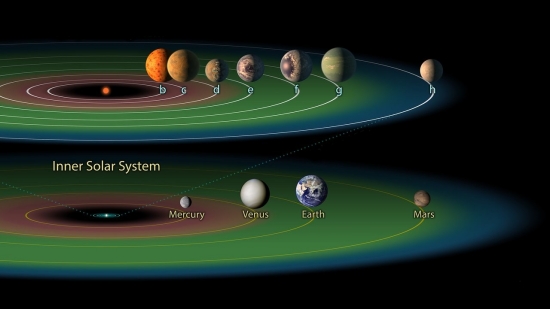
Image: The Trappist-1 planetary system has three planets in its habitable zone, compared to our Solar System, which has only one. (NASA/JPL/Caltech).
Out of such speculations came a way to analyze the question. Kane and team simulated gravitational interactions as planets at various distances from each other orbited their stars for millions of years. The upshot is that according to these calculations, a star like the Sun could support as many as six planets in liquid water habitable zone orbits. The fact that we do not see anything like this may just be the result of Jupiter and its ability to disrupt orbits because of its mass. Another needed trait of habitable zone planets: Their orbits need to be circular.
Kane’s team looked at the width of the habitable zone depending on spectral type and considered the dynamical constraints on stable orbits within the habitable zone, noting that “…dynamical constraints allow ~6 HZ Earth-mass planets for stellar masses ?0.7M?, depending on the presence of farther out giant planets.”
To examine these matters further, Kane has taken particular interest in Beta Canum Venaticorum (Beta CVn), a scant 27 light years away in the northern constellation Canes Venatici. This is a G-class star a bit more metal-poor than the Sun, although in most other respects it stands as a pretty fair double to our star in terms of mass and age. Maggie Turnbull (SETI Institute), a co-author on this paper, singled Beta CVn out as long as 12 years ago as one of the stars of possible astrobiological interest within 10 parsecs.
No planets are currently known here, but the very fact that there is no attendant gas giant makes Kane interested in looking for multiple smaller worlds. This is a nearby star that may yield transit results, based on the probabilities Kane calculates, and it offers the opportunity to test habitable zone packing scenarios. Finding nearby G-class stars without gas giants can be a profitable way to assess planetary orbital architectures, and to weigh how common our own Solar System’s might be:
Even though giant planets are more common around solar analogs than later-type stars (Zechmeister et al. 2013; Wittenmyer et al. 2016), they are still relatively rare, with an average occurrence rate of 6.7% beyond orbital periods of 300 days (Wittenmyer et al. 2020). Consequently, the solar system may not be representative of orbital architectures, and it is useful to directly compare with another nearby solar-type star, such as Beta CVn.
The paper presents 20 years of radial velocity data on Beta CVn from HIRES (Keck/High Resolution Echelle Spectrometer) as well as the Automated Planet Finder (APF) instrument, ruling out planets more massive than Saturn anywhere within 10 AU of the star. The potential packing given orbital dynamics around this star — numerous terrestrial-class worlds could exist here — show that relatively nearby targets like Beta CVn may also be interesting for space-based direct imaging missions of the future like HabEx and LUVOIR, as we begin to drill down toward smaller worlds in hopes of eventually characterizing their atmospheres.
Thus far we have primarily studied low-mass stars with transiting planets, which has revealed the phenomenon of compact, tightly packed systems. The paper goes on:
Some of these systems, such as TRAPPIST-1, have been found to have multiple terrestrial planets in the HZ, causing speculation as to whether such dynamical packing in the HZ is normal or rare. Our analysis presented here demonstrates that in fact the dynamical limitations to the packing of HZ terrestrial planets is ?5 planets for most spectral types, and ?6 planets for stellar masses ? 0.7M?. Packing 7 planets in the HZ is possible within certain specific stellar mass and architecture regimes, but becomes vulnerable to MMR [mean motion resonance] perturbations that compromise the dynamical stability of such configurations. The 20 years of RV data for Beta CVn presented here rule out a large range of giant planet masses and orbital parameters, providing an excellent candidate for complex terrestrial architectures.
A few thoughts on earlier work:
Highly packed stellar systems like TRAPPIST-1 also caught the attention of Alysa Obertas (University of Toronto). Obertas tackled the question in 2016, but a key unknown remained whether or not there is enough mass in the planet-forming disk to produce systems packed up to the limits allowed by computer simulations. The resulting paper looked at simulations involving up to 10 billion orbits, focusing largely on M-dwarf stars, of which TRAPPIST-1 is an example. “Applying the outcomes of our simulations, we show that isolated systems of up to five Earth-mass planets can fit in the habitable zone of a Sun-like star without close encounters for at least 109 orbits,” said the paper, making orbital stability unproblematic.
We’ve also talked about the implications of tightly orbiting planets in terms of astrobiology. 1530 light years away in Cygnus, Kepler-36 is orbited by a ‘super-Earth’ and a ‘mini-Neptune’ in orbits that differ by 0.013 AU, producing transit timing variations for both planets. Here we have a 7:6 orbital resonance, and presumably spectacular views from the molten surface of the super-Earth as the larger planet moves across its sky.
The system inspired work by Jason Steffen (UNLV) and Gongjie Li (Harvard-Smithsonian Center for Astrophysics), who extended it into speculations on the transmission of life between close planets in habitable zones. For that one, see Habitable Planets in the Same System.
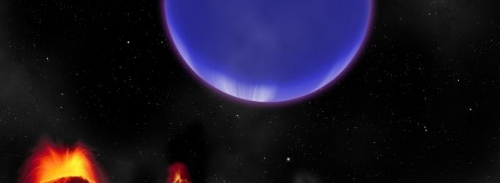
Image: A gas giant planet spanning three times more sky than the Moon as seen from the Earth looms over the molten landscape of Kepler-36b. Credit: Harvard-Smithsonian Center for Astrophysics.
The Kane et al. paper is “Dynamical Packing in the Habitable Zone: The Case of Beta CVn,” Astronomical Journal Vol. 160, No. 2 (27 July 2020). Abstract / Preprint. Also see Steffen and Li, “Dynamical considerations for life in multi-habitable planetary systems,” Astrophysical Journal Vol. 816, No. 2 (14 January 2016). Abstract / Preprint. The Obertas paper is “The stability of tightly-packed, evenly-spaced systems of Earth-mass planets orbiting a Sun-like star,” Icarus Volume 293 (1 September 2017), pp. 52-58 (abstract / preprint).

